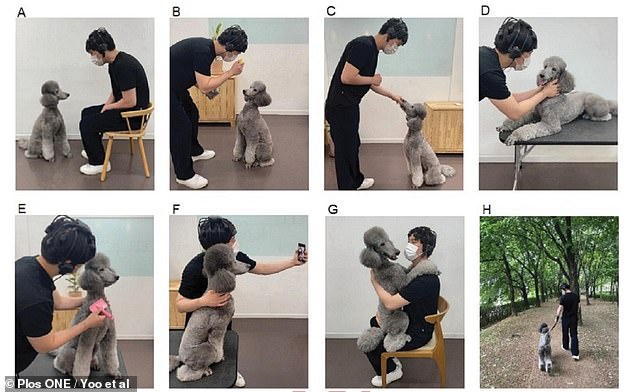Dogs really relieve stress! Spending quality time with a dog increases the power of brain waves associated with relaxation, research shows
- Participants performed activities with a dog while their brains were monitored
- Interaction with the dog increases relaxation, concentration and creativity
They are known for their loyalty, camaraderie and ability to make us laugh.
And research shows that spending quality time with man’s best friend also reduces stress and anxiety.
Researchers have found that interacting with dogs generates electrical activity in the part of the brain associated with relaxation, concentration, creativity and attention.
The team from Konkuk University in South Korea recruited 30 adult participants for their study.
They were asked to perform eight different activities with a well-trained four-year-old poodle, including playing with a hand toy, giving her treats and taking pictures with her.
They are known for their loyalty, camaraderie and ability to make us laugh. And it turns out that spending quality time with man’s best friend also reduces stress and anxiety, a study shows (stock image)
Analysis revealed that the power of alpha brain waves increased when participants played and walked the dog, reflecting a state of relaxation.
Meanwhile, grooming or gently massaging the poodle caused an increase in beta brain waves – a boost typically associated with increased concentration.
Those who took part in the study also reported feeling significantly less tired, depressed and stressed after all dog-related activities.
The team said that while ‘affection’ for the animal may have played a role in triggering these feelings, the findings add to evidence that dog therapy – often used in hospitals, schools and prisons – can help reduce anxiety and stress.
The authors wrote in the journal Plos One: ‘This study has shown that specific dog activities can activate greater relaxation, emotional stability, attention, concentration and creativity by facilitating increased brain activity.’

The team from Konkuk University in South Korea recruited 30 adult participants for their study. They were asked to perform eight different activities with a well-trained four-year-old poodle, including playing with a hand toy, giving her treats and taking pictures with her
Commenting on the study, Dr Jacqueline Boyd, senior lecturer in animal sciences at Nottingham Trent University, said the findings were ‘unlikely to come as a surprise to dog handlers’.
She said: ‘Quantitatively measuring brain activity in humans during direct interactions of different types with dogs further contributes to our understanding of the human-dog relationship.’
Dr. Boyd added that recruitment of the study participants was aimed at those who already enjoy dog interaction, so “suggestions that all interactions with all dogs will benefit all people should be viewed with caution.”
“The novelty of being involved in a study with a friendly dog should also be highlighted as a potential limitation of the data,” she said.
‘However, the reporting of measured physiological responses during dog interactions suggests that there is some consistency in the biological basis of human-dog interactions that may be useful in therapeutic encounters.’
